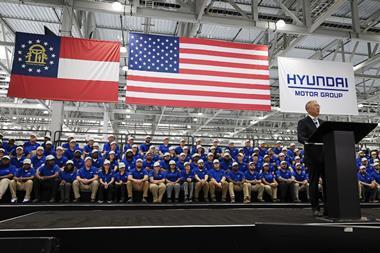
Prem Verma, chief executive of Tata Motors’ TML Distribution subsidiary, and Ford’s Amlan Bose, vice-president of material flow engineering, logistics network and export operations for Asia Pacific and Africa, revealed that they had opened up a close dialogue to work together on logistics at their neighbouring factories in Sanand, in the western state of Gujarat.
“Tata and Ford have discussed working together here and we’re waiting for a third OEM to take the place, next door to us, which was going to be occupied by Peugeot,” said Bose. “I had a meeting with Prem [Verma] and Ford’s global head of logistics, Steve Harley, and Prem told Steve that we should not compete on trucks and rail wagons, but rather in dealer showrooms.”
Verma added that it was also critical to work in close partnership with logistics providers, particularly at times of uncertainty. “The LSPs need to invest even if we cannot forecast accurately,” he said. “Our providers need to be able to plan.”
Indian logistics has many well-documented challenges, including an over reliance on road transport and maze of bureaucracy that can make moving goods in the country cumbersome and costly. Vinita Kumar, senior advisor for transport at the Indian government’s Planning Commission, encouraged many at the conference with the revelation that there were plans in the pipeline for each of these areas, with a planned investment across infrastructure over the next five-year plan amounting to between 7-10% of GDP or 50 lahk crore ($1 trillion).
This is to include a range of upgrades to rail infrastructure and rolling stock equipment, as well as roadworks and some port developments. Rail is to be at the centre of several important projects and investments with the development of high-density networks along the ‘golden quadrilateral’ stretching between Mumbai in the west, Kolkata in the east, Delhi in the north and Chennai in the south.
But speakers made it clear that there are still many policy changes and issues that need to be addressed before rail logistics could really take off for the automotive sector, including for the movement of finished vehicles.
It is something of which Prem Verma is already aware. In a feature interview in the forthcoming edition of Finished Vehicle Logistics magazine he outlines that while rail in India accounts for an 8% share of vehicle logistics, it is between 60-70% in the US and Germany.
This has to more than double over the next seven years. “Anything less than 20% movement [of vehicles] by the railways by 2020 could impact the transportation of vehicles to consumption centres and in turn impact auto’s planned growth trajectory,” he said.
Back at the conference Achal Paliwal, head of commercial and logistics for Honda Car India, pointed to numerous stops and starts on the policy side that have prevented rail from increasing its share of automotive traffic in recent years. The government has announced private sector reforms, only to go back on them or to delay them.
“Rail is a highly capital intensive investment, and what we’ve seen has been unwilling railways, hesitant LSPs and divided OEMs,” he said. “Many LSPs are waiting and watching the reforms [before investing].”
That said, there are moves being made, as last week’s news about APL-Vascor’s new service showed.
At the conference Bill Villalon, vice-president of automotive for APL, said the joint venture’s wagon, called AutoLinx, will be ready for viewing in early 2013. However, he admitted that before APL-Vascor could put the wagon into use, the government must finish its revision of the Automotive Freight Train Operator (AFTO) policy, which would open the way for private companies to operate terminals for automotive rail. He admitted that there was still “some ways to go”, but that he was hopeful that a revised policy would be finalised soon.

























![Global[1]](https://d3n5uof8vony13.cloudfront.net/Pictures/web/a/d/s/global1_726550.svgz)










